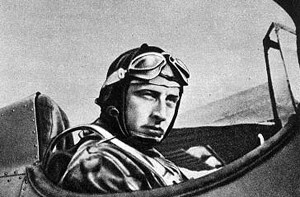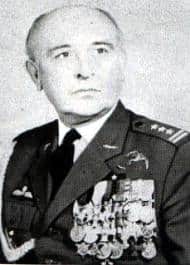

After completing his pilot training with the Polish air force, he joined the 4th Air Regiment going to 142 (Wild Ducks) Eskarda and was flying a PZL fighter when the Germans invaded Poland on 1 September 1939. Shortly after dawn on that day he shot down his first German plane and, in the next few days, reached ace status by shooting down a further six enemy aircraft. Skalski flew a sortie on 16 September, and the next day fled to Romania, as did many other Polish pilots. From there, he managed a daring journey via Beirut to Marseilles. From France, he transferred to the RAF in England in January 1940.
After further training in the Hurricane and Spitfire, he joined 302 Squadron in August. Eager to get into battle, he requested a posting from his unit, which was not yet operational. On 27 August, he joined 501 Squadron and was soon in action, gaining four more kills.

Polish Fighting Team, squadron leader-Stanislaw Skalski.
Early on 5 September, 501 Squadron took off to attack a large group of enemy aircraft. In his opening attack, Skalski hit an Hel 11 bomber and an escorting BflO9. He then launched a successful attack on another Messerschmitt.
When he turned to his map to note the area of victory, his aircraft was hit. The shells penetrated his fuel tank and his Hurricane caught fire. Although he managed to bail out, he was severely burned.
He hated being in the hospital with the Battle of Britain raging overhead and, although far from recovered, after only six weeks insisted on leaving the hospital to rejoin his squadron at the tail end of the battle. Because of his wounds, he could not run to his aircraft in response to the scramble bell, so he would sit on the airfield in his cockpit, waiting to go into action.
Stanislaw Skalski was born in Kodyma, north of Odessa in Russia, and moved with his mother to Poland in 1918. After his father escaped from Romania, he joined them in 1921. Stanislaw was educated at Dubno College and, after graduating from the Warsaw School of Political Science, joined the Polish air force in 1936.
In March 1941, Stanislaw Skalski left 501 Squadron and joined the 306 Polish Squadron and by the summer, had become the flight commander. It was a summer in which he was to claim another five victories. In May 1942, Skalski was given command of the Polish 317 Squadron at Northolt for an active five months tormenting the Luftwaffe, who were often reluctant to engage the RAF from their comfortable positions.
In January 1943, he created what was popularly known as Skalski’s ,,Cir-cus”. The Polish Fighting Team (PFT) was made up of the best Polish fighter pilots. After a month’s intensive training, the PFT arrived at Bu Grara airfield, some 150 miles west of Tripoli, for the Allies’ final push against Rommel. Flying the new Spitfire Mark IX, on 28 March the PFT drew its first blood. The flight, led by Skalski, encountered a group of Ju88s and destroyed two of them.
Skalski became the first Pole to command a British squadron when he was given command of 601 County of London Squadron flying out of Malta during the invasion of Sicily and Italy. By now, he had received the highest honor of his own country – the Virtuti Militari – and a second bar to his DFC was forthcoming in October 1943, when he returned to the UK to become Wing Leader of 131 Polish Wing at Northolt.
In April 1944, Skalski moved to 133 Wing and found much excitement in flying the Mustang III. On 24 June, he was attacked by BflO9s. Without firing a single shot, he executed a sudden darting action, which caused the two 109s to collide and crash to the ground.
Much to his chagrin, he was then sent on a staff course to the United States. On his return in February 1945, he became Wing Commander Operations at HQ11 group. At the end of the war, he elected to return to his beloved Poland and joined their new air force under Soviet aegis.

In 1989 Skalski did not attend any of the commemorative parades of the 50th anniversary of the German invasion of Poland. Rather, he sought out the whereabouts of the first German he had shot down and together, in the Bavarian Alps, they drank Schnapps.
Stanisław Skalski ,,Stan”
http://www.youtube.com/watch?v=VnrFgaC1-9o&feature=related
Photo: http://en.wikipedia.org/wiki/Stanis%C5%82aw_Skalski
